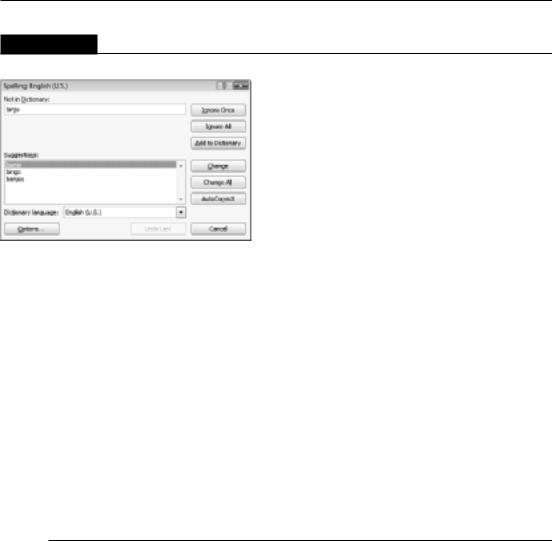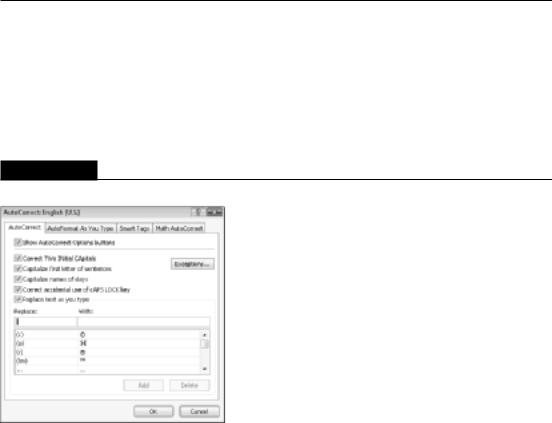
- •About the Author
- •About the Technical Editor
- •Credits
- •Is This Book for You?
- •Software Versions
- •Conventions This Book Uses
- •What the Icons Mean
- •How This Book Is Organized
- •How to Use This Book
- •What’s on the Companion CD
- •What Is Excel Good For?
- •What’s New in Excel 2010?
- •Moving around a Worksheet
- •Introducing the Ribbon
- •Using Shortcut Menus
- •Customizing Your Quick Access Toolbar
- •Working with Dialog Boxes
- •Using the Task Pane
- •Creating Your First Excel Worksheet
- •Entering Text and Values into Your Worksheets
- •Entering Dates and Times into Your Worksheets
- •Modifying Cell Contents
- •Applying Number Formatting
- •Controlling the Worksheet View
- •Working with Rows and Columns
- •Understanding Cells and Ranges
- •Copying or Moving Ranges
- •Using Names to Work with Ranges
- •Adding Comments to Cells
- •What Is a Table?
- •Creating a Table
- •Changing the Look of a Table
- •Working with Tables
- •Getting to Know the Formatting Tools
- •Changing Text Alignment
- •Using Colors and Shading
- •Adding Borders and Lines
- •Adding a Background Image to a Worksheet
- •Using Named Styles for Easier Formatting
- •Understanding Document Themes
- •Creating a New Workbook
- •Opening an Existing Workbook
- •Saving a Workbook
- •Using AutoRecover
- •Specifying a Password
- •Organizing Your Files
- •Other Workbook Info Options
- •Closing Workbooks
- •Safeguarding Your Work
- •Excel File Compatibility
- •Exploring Excel Templates
- •Understanding Custom Excel Templates
- •Printing with One Click
- •Changing Your Page View
- •Adjusting Common Page Setup Settings
- •Adding a Header or Footer to Your Reports
- •Copying Page Setup Settings across Sheets
- •Preventing Certain Cells from Being Printed
- •Preventing Objects from Being Printed
- •Creating Custom Views of Your Worksheet
- •Understanding Formula Basics
- •Entering Formulas into Your Worksheets
- •Editing Formulas
- •Using Cell References in Formulas
- •Using Formulas in Tables
- •Correcting Common Formula Errors
- •Using Advanced Naming Techniques
- •Tips for Working with Formulas
- •A Few Words about Text
- •Text Functions
- •Advanced Text Formulas
- •Date-Related Worksheet Functions
- •Time-Related Functions
- •Basic Counting Formulas
- •Advanced Counting Formulas
- •Summing Formulas
- •Conditional Sums Using a Single Criterion
- •Conditional Sums Using Multiple Criteria
- •Introducing Lookup Formulas
- •Functions Relevant to Lookups
- •Basic Lookup Formulas
- •Specialized Lookup Formulas
- •The Time Value of Money
- •Loan Calculations
- •Investment Calculations
- •Depreciation Calculations
- •Understanding Array Formulas
- •Understanding the Dimensions of an Array
- •Naming Array Constants
- •Working with Array Formulas
- •Using Multicell Array Formulas
- •Using Single-Cell Array Formulas
- •Working with Multicell Array Formulas
- •What Is a Chart?
- •Understanding How Excel Handles Charts
- •Creating a Chart
- •Working with Charts
- •Understanding Chart Types
- •Learning More
- •Selecting Chart Elements
- •User Interface Choices for Modifying Chart Elements
- •Modifying the Chart Area
- •Modifying the Plot Area
- •Working with Chart Titles
- •Working with a Legend
- •Working with Gridlines
- •Modifying the Axes
- •Working with Data Series
- •Creating Chart Templates
- •Learning Some Chart-Making Tricks
- •About Conditional Formatting
- •Specifying Conditional Formatting
- •Conditional Formats That Use Graphics
- •Creating Formula-Based Rules
- •Working with Conditional Formats
- •Sparkline Types
- •Creating Sparklines
- •Customizing Sparklines
- •Specifying a Date Axis
- •Auto-Updating Sparklines
- •Displaying a Sparkline for a Dynamic Range
- •Using Shapes
- •Using SmartArt
- •Using WordArt
- •Working with Other Graphic Types
- •Using the Equation Editor
- •Customizing the Ribbon
- •About Number Formatting
- •Creating a Custom Number Format
- •Custom Number Format Examples
- •About Data Validation
- •Specifying Validation Criteria
- •Types of Validation Criteria You Can Apply
- •Creating a Drop-Down List
- •Using Formulas for Data Validation Rules
- •Understanding Cell References
- •Data Validation Formula Examples
- •Introducing Worksheet Outlines
- •Creating an Outline
- •Working with Outlines
- •Linking Workbooks
- •Creating External Reference Formulas
- •Working with External Reference Formulas
- •Consolidating Worksheets
- •Understanding the Different Web Formats
- •Opening an HTML File
- •Working with Hyperlinks
- •Using Web Queries
- •Other Internet-Related Features
- •Copying and Pasting
- •Copying from Excel to Word
- •Embedding Objects in a Worksheet
- •Using Excel on a Network
- •Understanding File Reservations
- •Sharing Workbooks
- •Tracking Workbook Changes
- •Types of Protection
- •Protecting a Worksheet
- •Protecting a Workbook
- •VB Project Protection
- •Related Topics
- •Using Excel Auditing Tools
- •Searching and Replacing
- •Spell Checking Your Worksheets
- •Using AutoCorrect
- •Understanding External Database Files
- •Importing Access Tables
- •Retrieving Data with Query: An Example
- •Working with Data Returned by Query
- •Using Query without the Wizard
- •Learning More about Query
- •About Pivot Tables
- •Creating a Pivot Table
- •More Pivot Table Examples
- •Learning More
- •Working with Non-Numeric Data
- •Grouping Pivot Table Items
- •Creating a Frequency Distribution
- •Filtering Pivot Tables with Slicers
- •Referencing Cells within a Pivot Table
- •Creating Pivot Charts
- •Another Pivot Table Example
- •Producing a Report with a Pivot Table
- •A What-If Example
- •Types of What-If Analyses
- •Manual What-If Analysis
- •Creating Data Tables
- •Using Scenario Manager
- •What-If Analysis, in Reverse
- •Single-Cell Goal Seeking
- •Introducing Solver
- •Solver Examples
- •Installing the Analysis ToolPak Add-in
- •Using the Analysis Tools
- •Introducing the Analysis ToolPak Tools
- •Introducing VBA Macros
- •Displaying the Developer Tab
- •About Macro Security
- •Saving Workbooks That Contain Macros
- •Two Types of VBA Macros
- •Creating VBA Macros
- •Learning More
- •Overview of VBA Functions
- •An Introductory Example
- •About Function Procedures
- •Executing Function Procedures
- •Function Procedure Arguments
- •Debugging Custom Functions
- •Inserting Custom Functions
- •Learning More
- •Why Create UserForms?
- •UserForm Alternatives
- •Creating UserForms: An Overview
- •A UserForm Example
- •Another UserForm Example
- •More on Creating UserForms
- •Learning More
- •Why Use Controls on a Worksheet?
- •Using Controls
- •Reviewing the Available ActiveX Controls
- •Understanding Events
- •Entering Event-Handler VBA Code
- •Using Workbook-Level Events
- •Working with Worksheet Events
- •Using Non-Object Events
- •Working with Ranges
- •Working with Workbooks
- •Working with Charts
- •VBA Speed Tips
- •What Is an Add-In?
- •Working with Add-Ins
- •Why Create Add-Ins?
- •Creating Add-Ins
- •An Add-In Example
- •System Requirements
- •Using the CD
- •What’s on the CD
- •Troubleshooting
- •The Excel Help System
- •Microsoft Technical Support
- •Internet Newsgroups
- •Internet Web sites
- •End-User License Agreement

Part IV: Using Advanced Excel Features
FIGURE 32.17
Use the Spelling dialog box to locate and correct spelling errors in your worksheets.
The Spelling dialog box works similarly to other spell checkers with which you may be familiar. If Excel encounters a word that isn’t in the current dictionary or that is misspelled, it offers a list of suggestions. You can respond by clicking one of these buttons:
•Ignore Once: Ignore the word and continues the spell check.
•Ignore All: Ignore the word and all subsequent occurrences of it.
•Add to Dictionary: Add the word to the dictionary.
•Change: Change the word to the selected word in the Suggestions list.
•Change All: Change the word to the selected word in the Suggestions list and change all subsequent occurrences of it without asking.
•AutoCorrect: Add the misspelled word and its correct spelling (which you select from the list) to the AutoCorrect list.
Using AutoCorrect
AutoCorrect is a handy feature that automatically corrects common typing mistakes. You can also add words to the list that Excel corrects automatically. The AutoCorrect dialog box appears in Figure 32.18. To access this feature, choose File Options. In the Excel Options dialog box, click the Proofing tab and then click the AutoCorrect Options button.
This dialog box has several options:
•Correct TWo INitial CApitals: Automatically corrects words with two initial uppercase letters. For example, BUdget is converted to Budget. This mistake is common among fast typists. You can click the Exceptions button to specify a list of exceptions to this rule.
•Capitalize First Letter of Sentences: Capitalizes the first letter in a sentence. All other letters are unchanged.
672

Chapter 32: Making Your Worksheets Error-Free
•Capitalize Names of Days: Capitalizes the days of the week. If you enter monday, Excel converts it to Monday.
•Correct Accidental Use of cAPS LOCK key: Corrects errors caused if you accidentally pressed the CapsLock key while typing.
•Replace Text as You Type: AutoCorrect automatically changes incorrect words as you type them.
FIGURE 32.18
Use the AutoCorrect dialog box to control the spelling corrections Excel makes automatically.
Excel includes a long list of AutoCorrect entries for commonly misspelled words. In addition, it has AutoCorrect entries for some symbols. For example, (c) is replaced with ©, and (r) is replaced with ®. You can also add your own AutoCorrect entries. For example, if you find that you frequently misspell the word January as Janruary, you can create an AutoCorrect entry so that it’s changed automatically. To create a new AutoCorrect entry, enter the misspelled word in the Replace box and the correctly spelled word in the With field. You can also delete entries that you no longer need.
Tip
You also can use the AutoCorrect feature to create shortcuts for commonly used words or phrases. For example, if you work for a company named Consolidated Data Processing Corporation, you can create an AutoCorrect entry for an abbreviation, such as cdp. Then, whenever you type cdp, Excel automatically changes it to Consolidated Data Processing Corporation. Just make sure that you don’t use a combination of characters that might normally appear in your text. n
673

Part IV: Using Advanced Excel Features
Note
In some cases, you may want to override the AutoCorrect feature. For example, you may need to literally enter
(c) rather than a copyright symbol. Just click the Undo button on the Quick Access toolbar or press Ctrl+Z. n
You can use the AutoFormat as You Type tab of the AutoCorrect dialog box to control a few other automatic settings in Excel.
Use the Smart Tags tab to make Excel show Smart Tags — similar to hyperlinks — for certain types of data in your worksheets. The types of Smart Tags Excel recognizes vary depending on the types of software that are installed on your system.
The Math AutoCorrect tab contains shortcuts used to enter symbols when working in the Equation Editor (see Chapter 22).
674

Part V
Analyzing Data
with Excel
Excel is a superb data analysis tool — if you know how to extract the information you really need. In this part, you’ll learn how to obtain and analyze data
in Excel. As you’ll see, many of the data-analysis capabilities in Excel are both surprisingly powerful and easy to use.
IN THIS PART
Chapter 33
Getting Data from External Database Files
Chapter 34
Understanding Pivot Tables
Chapter 35
Analyzing Data with Pivot Tables
Chapter 36
Performing Spreadsheet What-If
Analysis
Chapter 37
Analyzing Data Using Goal
Seeking and Solver
Chapter 38
Analyzing Data with the Analysis ToolPak
